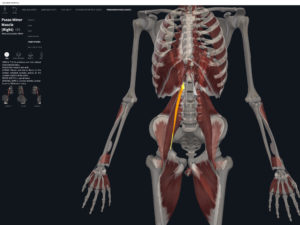Anatomy & Physiology: Muscles—Psoas Minor.
Structure.
- Origin: bodies of T12 and L1 and intervening intervertebral disc.
- Insertion: fascia covering psoas major and iliacus.
Function.
- Concentric action: accelerates hip flexion and external/lateral rotation; extends and rotates lumbar spine.
- Reverse mover action: pelvis posterior tilt, lower trunk flexion, ipsilateral pelvic elevation.
- Eccentric action: controls/restrains/decelerates hip extension and internal rotation.
- Isometric action: stabilization of lumbo-pelvic hip complex.
- Innervation: spinal nerve branches of L2-L3.
- Arterial supply: lumbar arteries, arteria lumbalis ima of median sacral artery, lumbar part of iliolumbar artery, common iliac artery.
Clinical Significance.
References
Biel, A. (2015). Trail guide to the body: A hands-on guide to locating muscles, bones and more.
Cedars-Sinai. (2018). Vertebrae of the spine. Retrieved from https://www.cedars-sinai.org/health-library/diseases-and-conditions/v/vertebrae-of-the-spine.html
Clark, M., Lucett, S., Sutton, B. G., & National Academy of Sports Medicine. (2014). NASM essentials of corrective exercise training. Burlington, MA: Jones & Bartlett Learning.
Jenkins, G., & Tortora, G. J. (2012). Anatomy and Physiology: From Science to Life, 3rd Edition International Stu. John Wiley & Sons.
Muscolino, J. E. (2017). The muscular system manual: The skeletal muscles of the human body.

